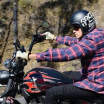That is the vision of BMW which has developed the C1-E as part of a European study into traffic congestion. BMW produced a petrol C1 in 2001 and 2002, but scrapped it when some countries required riders to wear a helmet.
Now the idea is back on the drawing board as BMW's contribution to the European safety project eSUM (European Safer Urban Motorcycling), along with scooter manufacturer Piaggio.
The BMW C1-E is powered by a Vectrix electric motor and has a raft of car-like safety features including a safety cell, roll-over bar, front crumple zone and even a seat belt. The new version of the C1 has a more aerodynamic look with a lower centre of gravity, raked windscreen and a car-like boot.
The Vectrix motor comes with a new compact and lightweight lithium-ion battery, but BMW has not ruled out a small-capacity low-emission internal combustion engine. BMW Motorrad Australia product communications manager Tim James said the C1-E was “just a study about how to manage traffic at the moment and there are no plans for production”.
However, BMW will use its findings to develop single-track vehicles. The cities involved in the eSUM project include Paris, Rome, Barcelona and London. BMW claims two-wheeled transportation would improve traffic flow, but has inherent safety problems.
Their scooter would likely be fitted with some of the primary safety devices now being fitted to their motorcycles such as traction control, tyre pressure monitors and anti-skid brakes.
BMW is also researching rider assistance systems designed to increased road safety such as traffic-light assistance and a warning system for wet weather, road obstacles, an approaching emergency vehicle, or sudden braking manoeuvres.

































.jpg)

